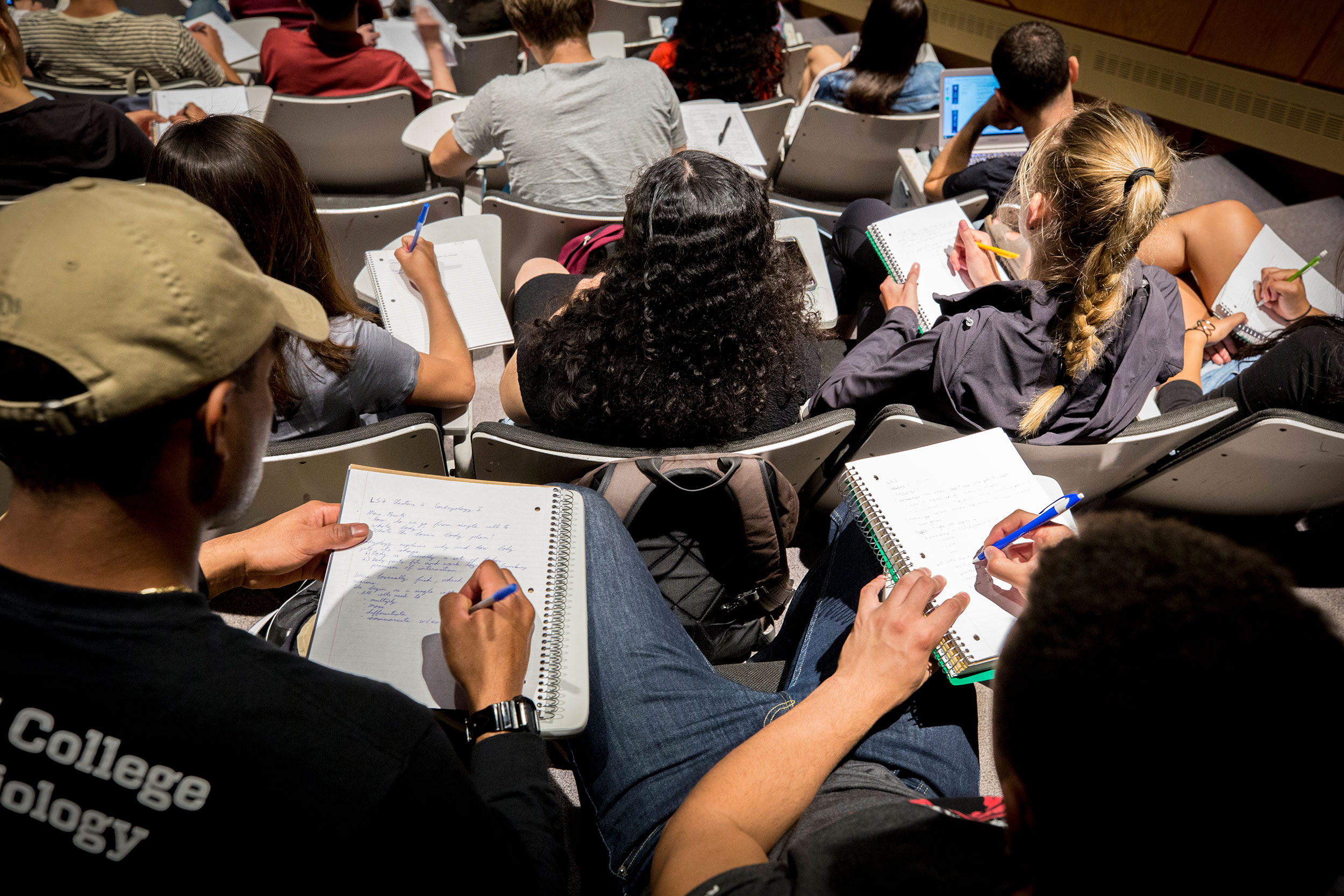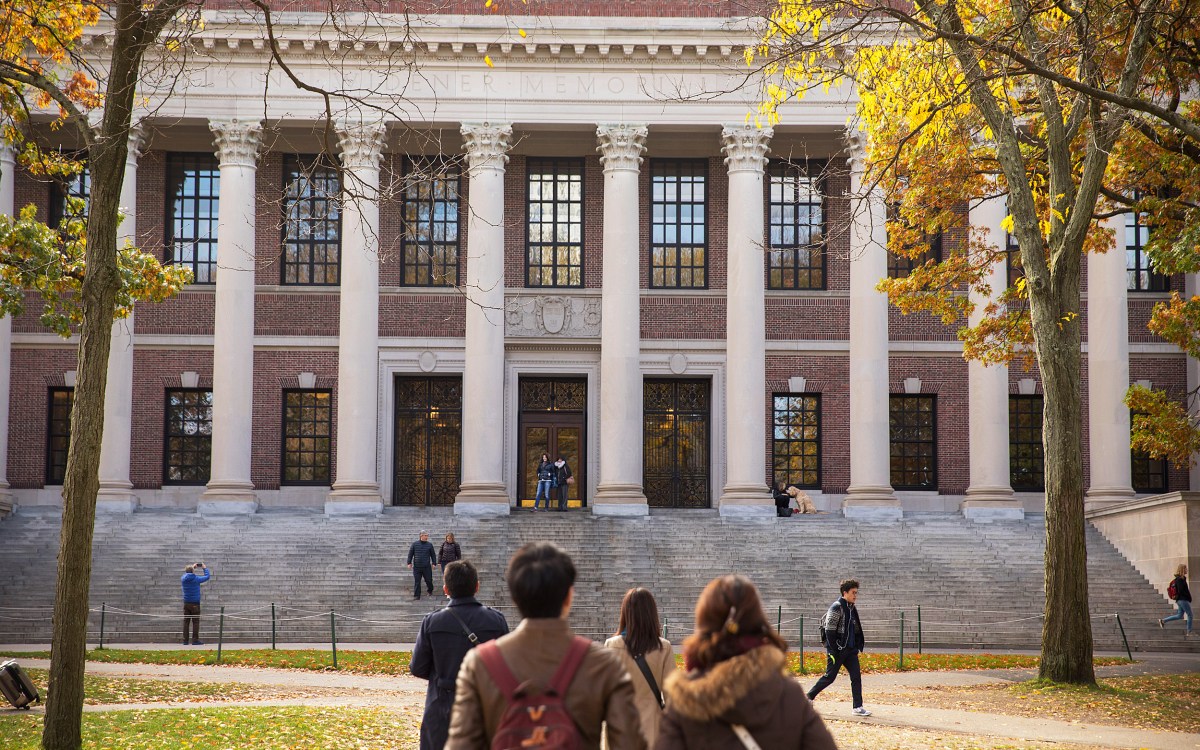
With a record applicant pool, Harvard has admitted 1,962 students to the Class of 2022.
Rose Lincoln/Harvard Staff Photographer
1,962 admitted to Class of ’22
College’s applicant pool was a record 42,749
Finding the college that provides the best match is often a lengthy process for applicants, but 1,962 students just learned they will have Harvard College to consider from among the many possibilities around the nation and the world.
The 1,962 were admitted from a record applicant pool of 42,749, and they have until May 1, the national common reply date, to make their final college choices. If they decide to attend Harvard, they will live with and learn from classmates who represent unprecedented economic diversity, remarkable academic and extracurricular accomplishments, and a broad array of ethnic and international backgrounds.
This year a record 20.3 percent of the admitted students come from modest and low-income backgrounds that make them eligible for Federal Pell Grants.
“Since the start of the Harvard Financial Aid Initiative (HFAI) nearly 15 years ago, the percentage of entering classes receiving Pell Grants has doubled, as has the applicant pool,” said William R. Fitzsimmons, dean of admissions and financial aid. “HFAI has totally transformed our ability to reach out to students who traditionally might not have thought about applying to Harvard — or to any college — because of college costs. The clear message HFAI provides — that college is affordable for low- and middle-income students — has led many students to Harvard and to other public and private colleges as well,” he said.
At Harvard, more than half of students receive financial aid, and for 70 percent of those students, their grant covers the full cost of tuition. The majority of undergraduates receiving financial aid pay just 10 percent of annual family income, with the average net cost to parents being about $12,000 a year. One in five Harvard undergraduates comes from a family earning less than $65,000 a year, and the families pay nothing toward the cost of education. These students now also receive a $2,000 start-up grant that helps with move-in costs and other expenses incurred in making the transition to the College.
“Because of HFAI, Harvard costs the same or less for 90 percent of American families than in-state public universities,” said Sarah C. Donahue, Griffin Director of Financial Aid. “In addition, financial aid is provided on the same basis to all needy families, both domestic and international,” she said.
“Coming from a single-parent, low-income background, I knew that Harvard’s financial aid packages would make my ability to attend Harvard less financially stressful for my family,” said Sarah Grammar ’18. “Without the generous, need-based aid, I know that I could not have attended this great college and could not have had the incomparable experience of being a student at Harvard.”
Women constitute 50.1 percent of the admitted students, compared with 49.3 percent last year. The geographic origins and the academic interests of the incoming class are also similar to last year’s class. African-Americans constitute 15.5 percent of the class, Asian-Americans 22.7 percent, Latinos 12.2 percent, Native Americans 2 percent, and Native Hawaiians 0.4 percent. First-generation students are 17.3 percent of the class, up from 15.1 percent last year. International citizens are 12 percent of the class, and they come from 90 countries.
“Recruitment remains critically important in assembling outstanding classes each year,” said Anne De Luca, associate dean for admissions and financial aid recruitment. “From our initial contact with prospective students in their junior year using mail, social media, and extensive travel to 150 locations throughout the U.S. and beyond, we urge promising students to consider higher education generally and Harvard in particular,” she said.
The Undergraduate Minority Recruitment Program, HFAI, the Harvard First Generation Program, the Harvard College Connection, and the Undergraduate Admissions Council all play crucial roles in recruitment efforts. Throughout the year, undergraduates reach out to prospective applicants by mail, social media, and hometown high school visits, and they provide hosting and tours for visitors.
“Our 10,000 alumni who attend college nights, interview candidates, host admit parties, and telephone admitted students devote countless hours each year to our efforts,” said Marlyn E. McGrath, director of admissions. “They are critical to our success in enrolling such outstanding classes each year and often forge lifetime friendships and mentorships with students in the process.”
Members of the teaching faculty, admissions and financial aid officers, and students will write personal notes, make phone calls, employ social media, and meet with admitted students as part of Harvard’s comprehensive recruitment efforts. Admitted students will be invited to attend Visitas, a weekend program that offers them a wealth of information about life in Cambridge. This year’s Visitas will be held April 21‒23, although students may visit at other times as well.
“Admitted students have many attractive college options, and Visitas can make the difference in having students choose to come to Harvard,” said Timothy J. Smith, director of the program.
“Visitas was so important to me because it allowed me to really envision myself as a Harvard student,” said Deigo Navarrete ’21. “I was able to visibly see the diversity that Harvard has to offer and feel like there were several communities that were ready to welcome me in.”
The financial aid office gets many questions from students and families throughout April. “We will talk with hundreds of families during this time, and we are happy to do everything we can to ensure that Harvard is affordable for all admitted students,” said Donahue.
“Harvard’s financial aid program was better than any other school I had applied to,” added Navarrete. “It was an offer that I could not turn down, and my parents would have made sure that I didn’t.”







